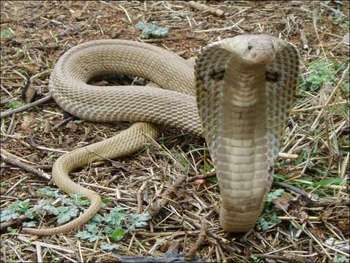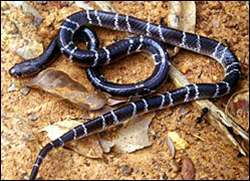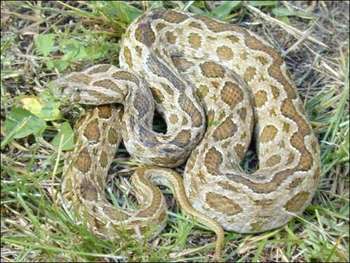Snake! The very word seems to evoke a feeling of terror in the mind of the average person; but if one has better knowledge of these creatures, one can see that much of the dread is misplaced. Here are some FAQs (Frequently Asked Questions) about snakes, answered by P Gowirshankar, a herpetologist who has been actively associated with the Agumbe Rainforest Research Station (ARRS), which has had the only telemetry project for tracking the King Cobra in that region. Gowrishankar is at present located in Bangalore, pursuing his doctoral studies.

The Spectacled Cobra has a distinctly visible black mark in the neck area, that forms the ‘V’ when the snake opens its hood. Pic Courtesy: Wikimedia Commons.
1. I see a snake in my yard or house, and I don’t want to go close to find out if it is poisonous or not. My first instinct is to panic. What should I do? Will my actions be different in case the snake is quiet, and in case it is moving about? What if it is in an odd place where it cannot be easily dislodged/chased off?
Yes, the first instinct is to panic, nothing much can be done about that. If you are aware and can do it, do your best to replace that fear with knowledge and act accordingly. If the snake is moving constantly keep a watch on it from a safe distance. If the snake is coiled up or resting nothing much to worry, do not disturb it but do keep a watch. Call any of the animal welfare organizations in Bangalore and they will help retrieve the snake.
2. In case I am bitten, or I see someone bitten by a snake, what should I do? (Especially if the snake is no longer around, and I cannot find out if the snake was venomous or not)
Not all snake bites are from venomous snakes. However do look out for the following symptoms and follow the first aid listed below:
General symptoms of a bite from a venomous snake:
- Wound site: Fang marks, discoloration, burning sensation, blistering of skin, local pain, oedema
- Bleeding from the wound that does not seem to stop
- Bleeding gums
- Progressive swelling of the bitten limb
- Drooping eyelids
- Difficulty in speaking
- Difficulty in breathing
- Drowsiness, unsteadiness
First Aid
- Calm and reassure the patient. Only a small percentage of snakebites prove serious. Panic can increase the heart rate and speed the spread of venom in the body.
- Remove any constricting items worn by the patient such as bangles, bands, bracelets, finger rings, watch and so on.
- Completely immobilize the patient: Lay them down and keep them still. Splint the bitten limb to prevent movement.
- A bitten leg should be splinted from below the ankle to the top of the thigh, and then strapped to the other leg to keep the entire lower half of the body still. A bitten arm should be splinted from the fingertips to the shoulder, and then strapped firmly (not tightly) to the side of the body.
- Keep the wound clean; do not apply mud, manure or other poultices, if the wound requires washing use uncontaminated water to gently clean it.
- Do not allow the person to walk or move about; keep them completely immobile and take them to hospital as soon after the bite as possible.
- The victim should be kept warm. Watch out for the general symptoms (listed above) and inform the doctor:

The Common Krait. Pic Courtesy: Wikimedia Commons.
The only remedy for venomous snakebite is anti-venom serum. Polyvalent anti-venom serum is effective against the bites of the Big Four: Common Cobra, Saw-scaled Viper, Common Krait, Russell’s viper.
Note: Only if safely possible, try and get a good look at the snake (or photograph it) to help the doctor identify it, and treat the bite accordingly.
Here’s what you should not do when a person has been bitten by a snake
- Do not give sedatives to calm the patient.
- Do not tie an electric cable, string or rubber tourniquet or ligatures, and do not cut the bite site, or the bitten limb.
- Do not use ice packs, electric shock or suction at the site of bite.
- Do not elevate the limb.
- Do not use potassium permanganate.
- Do not let the patient walk or run; keep them absolutely immobilized.
- Do not administer alcoholic beverage or any medication
- Do not give food or water, as both may be a choking hazard if the person vomits.
- Do not waste time with quack ‘remedies’ such as ‘snake stones’, or chanting mantras. Go for anti-venom serum without delay.
3. Where would I be able to get snake anti-venom in Bangalore?
Anti-venom is stocked in most leading hospitals of Bangalore, including Manipal Hospital, Baptist Hospital, Mallya Hospital, Bowring Hospital and St John’s Medical Hospital.
4. Should I administer anti-venom in any case? If the snake was not a poisonous one, will the anti-venom have bad effects?
No. Medical assistance is mandatory as it has to be administered through intravenous means. It is best for doctors to take a call on whether to administer anti-venom after observing the symptoms. Unnecessary use of anti-venom may cause allergic reactions.
5. What should I do to prevent snakes from entering my garden or home? I know they are good for the ecosystem, but I don’t want to deal with them.
Keep the garden clean and free from mounds of litter. Keep flower pots away from doors and windows and do not stock them close to each other. Make sure there are no rats breeding in the garden or in the house. Keep the place well lit; else use a torch to move around.

The Russel’s Viper has a distinctly triangular head, prominent because of a slender neck, with a thick body, and a thin tail. Pic Courtesy: Wikimedia Commons.
6. Is it true that snakes are to be found where there are termite mounds?
Not necessarily. They need to regulate their body temperature so depending on the temperature, humidity, habitat and prey base they select resting places, and a termite mound is just one such resting place.
7. Is it useful to call in a snake-charmer? If so, how can I locate one?
It is better to contact animal welfare organizations like the following:
Compassion Unlimited Plus Action (CUPA)
LR Nagar, Koramangala
Bengaluru – 560047
Ph No 22947302
Bannerghatta Rehabilitation Centre (WRRC)
Survey No. 129, Jigni Hobli,
Anekal Taluk, Bannerghatta,
Bangalore – 560 083
Ph No 22947307/ 22947300/ 22947301
wrrcbrc[at]gmail[dot]com
Karuna Animal Welfare Association Of Karnataka
Kasturba Road, Cubbon Park
Bangalore- 560001
Ph No 22860205, 23411181
People for Animals
Survey no. 67,
Uttarahalli Road, Kengeri,
Bangalore 560 060
Ph No 2860 4767, 2860 3986, 2273 3350, 9980339880
8. Are there any common misconceptions about snakes in urban areas that I should be aware of?
There are many myths and misconceptions about snakes, which not differ much between urban and rural areas. Four of the common myths are:
a) Cobras take revenge
b) They drink milk
c) Talking about snakes at home is equal to inviting them.
d) Male combat of snakes is misunderstood to be mating and the superstition is that viewing this invites trouble for generations. ⊕
Related Articles
Nice article Deepa and thanks to Gowrishankar to for the information.
My question is what happens if a snake bites a pet? Does the same anti-venom work or do we have to take it elsewhere?
My pleasure, thank you!
Will ask Gowri to see this link and answer your question right here!
Hello Vishwanath,
If a snake bites a pet the first aid procedure is the same. Take the pet to a veterinarian as soon as possible and he will administer anti-venom. The poly-valent anti-venom used for humans works for animals too.
Something that I had included in the original article:
Q. Can I stock anti-venom at home?
A. You can stock anti-venom as part of your first-aid kit, and it would be better if it is refrigerated. Perhaps, if you are going on a rough nature trail/trek, you could carry anti-venom along, too. But it is definitely better to take a snake-bite victim to a doctor immediately, as the anti-venom must be administered by a medically trained person.
Hi,
I really appreciate this info which is very handy. Any articles on Bee hive removal? Of late I am seeing they are being killed by pesticides.
Regards,
Avinash
Deepa. Thankyou for putting this very informative & helpfull post & i will be linking this article to my website page on Snakes & reptiles of Agumbe.
A cobra has been spotted in my compound by security guards, twice within the lastmonth. It is a sizable one… nearly 4-5 feet in lenght. We have been living in the 8000 sq ft proprty which has tons of plants and trees since 30 years. The concern is for our toddlers who might be in danger. Pls advise, what is the appropriate next step, how do we catch the snake and rehabilitate it. We dont want to risk a tragedy.
Hi Yvonne. .
1. In my experience, even common non-venomous snakes are identified as cobras by security guards and, indeed, many panic-stricken people, In 8 cases out of ten, we find that it is a non-venomous snake (a keelback or a rat snake). I do not rule out the possibility that it might indeed be a venomous snake such as a viper, a krait or a cobra.
2.Catching the snake is itself a very risky procedure, and there is no guarantee that there will be only one snake. Areas with a lot of undergrowth attract snakes (venomous or not) repeatedly. Also, “rehabilitation” of a wild creature is often condemning it to death. A wild creature in a new area is an alien, and often dies of starvation or is killed by the “local” animals. It is not a simple matter of taking a snake from place “A” and dropping it in “B”. So…”rehabilitation” is a way of killing the snake almost as surely as beating it up on sight.
3. Your best bet, therefore, is to make the area unattractive to snakes. Please, co mpletely clear the compound of all heavy undergrowth, and any logs of wood or debris lying around, which could give snakes shelter. Leave the large plants and trees, do not let dense, weedy undergrowth persist. This way, the snake will not come in as there will be no place for it to lurk. This way you are ensuring that not only the snake seen last month, but in the future, too, no snakes will lurk there, and this will make the area safe for the toddlers…and perhaps pet dogs and cats, too. Hope this helps. Perhaps the property may not look as “picturesque”, but it will be much safer.
Thank you very much for your detailed response Deepa. Thankfully the brush and dry leaves pile is away from the house. However I have a hunch the snake like to visit near our water tank to cool off from the excess spill over. Definitely empathize with the snake given the fact he may have as much right to be here as us. He hasnt shown up for sometime now. Hopefully he is keeping to the other side of the property. Thanks for those thoughts on rehabilitation. It is informative. I had the impression that relocation works. Your response definitely helped and is much appreciated. We will remain careful but it looks like all is good for now. Cheers
You can contact the below organisations/ people, who can help to rescue the snake.
1) Vanamitra – Run by Suresh and Jaishankar, Vanamitra is an NGO engaged in wildlife rescue, conservation and education. They have volunteers across Bangalore. I am one of their volunteers and attend to calls around Sarjapur Road and Hosa Road areas.
Suresh – 92434 14950
Jaishankar – 95903 31323
Prithvi Raj – 98869 28580 (Sarjapur Road, Hosa Road)
2) Sharath Babu, Wildlife Warden, Bangalore – Sharath Babu is an environment advisor to BBMP. He too has many volunteers across Bangalore.
Sharath Babu – 98801 08801
3) The Gerry Martin Project – Run by Gerard Martin, The Gerry Martin Project is an NGO engaged in wildlife rescue, conservation and education. They have volunteers across Bangalore. I am one of their volunteers and attend to calls around Sarjapur Road and Hosa Road areas.
Sumath Madhav – 98808 72975
Thanks Deepa. Nice article and good information. Thanks for putting it together though I am finding it 5 yrs later! Q: Are there any type of plants that may act as a deterrent to snakes due to its smell or general nature?
Q: Are there any type of plants that may act as a deterrent to snakes due to its smell or general nature?